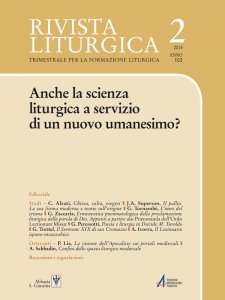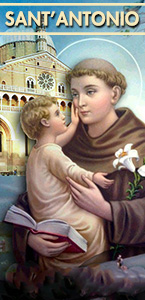STUDI
C. Alzati
Chiesa, culto, esegesi
L’affermazione di Gregorio Magno che l’esegeta ab historia in mysterium salutis surgit ben esprime l’organica unità dell’esperienza cristiana antica, nella quale kerygma e proclamazione solenne delle Scritture si presentano come un tutto unitario, in cui ciascun elemento risulta agli altri inscindibilmente connesso. Tale realtà trova in Ambrogio un interprete particolarmente rappresentativo. In lui anche il complesso rapporto tra Antico e Nuovo Testamento risulta trarre dall’esperienza misterica la propria organica ricomposizione. Al riguardo va osservato come a Milano mai sia venuta meno la presenza della Lectio veterotestamentaria. In questo ininterrotto accostamento dell’Antico e del Nuovo Testamento nella loro sintesi misterica, si può affermare che la Chiesa Ambrosiana abbia efficacemente espresso il proprio radicamento nell’esperienza testimoniata dal suo antico pastore.
Church, cult, exegesis
The statement by Gregorius the Great that the exegete «ab historia in mysterium salutis surgit», expresses well the organic unity of the ancient Christian experience, in which kerygma and solemn Word’s proclamation were presented as a unitary whole where each element turns out to be connected to the others in an inseparable way. This matter of fact finds in Ambrose a peculiarly representative interpreter. In him also the complex relationship between Old and New Testament results to draw from the mystery experience its own organic reassembling. With regard to this we must note that in Milan the presence of the Lectio from Old Testament has never been omitted. In this continuous approach of the Old and New Testament in their mystery synthesis, we are able to affirm that the Ambrosian Church has effectively expressed its rootedness in the experience that is testified by its ancient pastor.
J.A.Superson
Il pallio. La sua forma moderna e teorie sull’origine
Per numerosi secoli nella Chiesa Cattolica Romana ci si esprimeva sul tema del pallio e della sua origine. Nell’articolo in modo cronologico sono stati presentati i seguenti autori: P. de Marca, G. Moroni Romano, F. Vespasiani, R. Garrucci, Ch. de Rohault de Fleury, G. Morin, L. Duchesne, J. Wilpert, H. Grisar, A. J. Nowowiejski, J. Baudot, J. Braun, H. Leclercq, M. Righetti, R. Lesage, B. Neunheuser, J. Lewandowicz, S. Piccolo Paci che hanno analizzato il fenomeno della provenienza del pallio romano. Le ricerche relative a questa insegna romana - una veste - così intense nella seconda metà del XIX sec. e all’inizio del XX sec., non hanno elaborato una teoria unica nei suoi confronti, possibile da accettare come consenso dell’intero ambiente scientifico. L’ipotesi secondo cui il pallio sarebbe provenuto dal mantello di san Pietro viene rigettata in massa. Anche la testimonianza della donazione costantiniana viene rifiutata. Invece le altre teorie sembrano più o meno probabili, ma ciò non significa che sono convincenti. La mancanza di fonti storiche lette in modo univoco fa sì che tutte le teorie abbiano qualche difetto.
The pallium. Its modern form and theories about its origin
For many centuries the Roman Catholic Church, talks about the pallium and its origin. In the article in the chronological order there have been introduced the authors: P. de Marca, G. Moroni Romano, F. Vespasiani, R. Garrucci, Ch. de Rohault de Fleury, G. Morin, L. Duchesne, J. Wilpert, H. Grisar,A. J. Nowowiejski, J. Baudot, J. Braun, H. Leclercq, M. Righetti, R. Lesage, B. Neunheuser, J. Lewandowicz, S. Piccolo Paci, who analysed the provenance of the Roman pallium. Researches on this Roman insignia - a robe- , just very intense in the second half of the nineteenth century and early twentieth century, have not elaborated, the one theory, acceptable as a consensus for the scientific community. Hypothesis that the pallium was from St. Peter’s mantle is collectively rejected. Certificate of Constantinian donation is also negated. However the other theories seem remaining more or less probable, that does not mean that they are convincing. There are no historical sources read in a critically clear way, and it makes that all theories have some gaps.
G. Tornambé
L’inno del Crisma
L’introduzione dell’innoO Redemptor sume carmen, è propria del Pontificale Romano-germanico. Passato nel Pontificale Romano del XII secolo è giunto fino ai nostri giorni. La sua esecuzione è prevista durante la processione degli oli della messa crismale. Si tratta di un inno strofico in forma responsoriale attribuito a V. Fortunato. Ne proponiamo un’analisi teologica.
The hymn of the Chrism
The introduction of O Redemptor sume carmen hymn is typical of Romano-Germanic Pontifical. It transited into XII century Roman Pontifical and so it has arrived until us. Its performance is possible during the procession of oils during the chrismal mass. It is a strophic hymn in responsorial shape, attributed to V. Fortunato. We propose here a theological analysis.
G. Zaccaria
Ermeneutica pneumatologica della proclamazione liturgica della Parola di Dio. Appunti a partire dai Prænotanda dell’Ordo Lectionum Missæ
A partire da alcune suggestioni presenti nell’opera di A. M. Triacca, vengono esplorati i Prænotanda dell’Ordo Lectionum Missæ, con lo scopo di individuarvi alcuni modi di presenza e di azione dello Spirito Santo. I principi ermeneutici a sostrato pneumatologico estratti dallo studio di tali Prænotanda vengono poi applicati a diversi ambiti: all’ambito della Parola proclamata, a quello del rapporto tra proclamazione liturgica e partecipazione dei fedeli, ed infine all’ambito del rapporto tra la Parola proclamata e celebrazione dei sacramenti. L’obiettivo è duplice: da una parte suggerire ambiti di approfondimento della presenza e dell’azione dello Spirito Santo in questo segmento celebrativo; e, dall’altra, mostrare la ricchezza dei Prænotanda dei libri liturgici quali fonti per la teologia liturgica.
A pneumatologic hermeneutics about the liturgical proclamation of the Word of God. Some remarks starting from the Praenotanda of the Ordo Lectionum Missae
Taking as starting point some suggestions that are proposed in his work by A.M. Triacca, in this essay are explored the Praenotanda of the Ordo Lectionum Missae in order to single out some ways of presence and action of the Holy Spirit. Hermeneutic principles with a pneumatologic substratum, which emerge from the study of these Praenotanda, are then applied to different aspects: to the Word’s proclamation, to the relationship between liturgical proclamation and faithful participation and finally to the relationship of the proclaimed Word with the sacraments celebration. The aim is twofold: first of all to suggest aspects of a further investigation on the presence and action of the Holy Spirit within this part of the celebration; then to show the richness of the liturgical books Praenotanda as sources for the liturgical theology.
G. Peressotti
Poesia e liturgia in Davide M. Turoldo
Con il presente lavoro intendiamo investigare il rapporto tra letteratura e liturgia nell’opera poetica di David Maria Turoldo, un friulano appartenuto all’Ordine dei Servi di Maria. Nella sua ampia produzione poetica egli ricorre frequentemente al mondo della liturgia. Ma, a parte l’Ufficio divino, per il quale l’Autore si è ampiamente impegnato – col creare numerosi inni e con la reiterata versione poetica dei salmi – il suo riferimento al culto cristiano non è di tipo sistematico, bensì episodico ed esperienziale. Dotato di una parola tagliente, Turoldo ripercorre la propria esistenza articolandola attorno alle feste religiose celebrate soprattutto nel tempio della natura.
Poetry and liturgy in David M. Turoldo
In this essay we are aiming to investigate the relationship between literature and liturgy in the poetic works by David M. Turoldo, a native of Friuli, who became a friar in the Order of Servants of Mary. In his wide poetic production ,he often refers to the world of liturgy. But, apart from the divine Office, for which the A. has engaged himself largely – creating many hymns and a repeated poetic version of Psalms – his reference to the Christian cult is not a systematic one, but episodic an experiential. He was endowed with a sharp word: Turoldo thinks over his own existence, developing it around the religious festivities, that are celebrated above all in the temple of nature.
G. Trettel
Il Sermone XIX di san Cromazio
L’autore prende in esame il sermone XIX, che ha per tema la crocifissione del Signore, a partire dalla citazione di Matteo 27,27-28. Cromazio commenta gli strumenti della passione del Signore (la tunica di porpora, il mantello scarlatto, la corona di spine, la canna posta nelle sue mani, la croce da portare al Calvario), l’irrisione subita, e ne esamina il significato tipologico, il loro valore ecclesiale, rimarcando il valore salvifico e redentivo della croce, mettendo poi in relazione il primo Adamo con il secondo Adamo, il tipo con l’antítipo, ossia l’Adamo della Genesi con il Signore Gesù, la figura con la Veritas, evidenziando cioè il rapporto che corre tra l’AT e il NT. In questo modo Cromazio giunge pure a collegare il luogo nel quale - secondo un’antica tradizione che Cromazio fa propria - Adamo era stato sepolto sul Calvario, proprio dove il Signore e Redentore venne crocifisso per la salvezza dell’uomo, riscattando così l’uomo dalla colpa del progenitore.
The XIX Sermon by saint Chromatius
The A. takes into consideration the 19th Sermon, which has the Crucifixion of the Lord as a topic, starting from the quotation of Mt 27,27-28. Chromatius comments the tools of Lord’s Passion (the purple tunic, the scarlet mantle, the crown of thorns, the reed put on his hands, the cross he must carry up to the Calvary), the derision he suffered, remarking the redeeming and saving value of the cross and then connecting the first Adam with the second Adam, the typos with the anti-typos, i.e. the Adam of Genesis with the Lord Jesus, the symbol with the Truth: in this way the relationship between Old and New Testament is pointed out. Chromatius connects also the place of the Calvary with the place where Adam had been buried – according to an old tradition that Chromatius accepts. In the same place our Lord and Redeemer was crucified for mankind’s salvation, so setting humanity free from the guilt of our progenitor.
A. Ivorra
Il Lezionario ispano-mozarabico
La parola di Dio nella celebrazione liturgica, soprattutto in quella eucaristica, si presenta come un dialogo di Dio con il suo popolo e testimonia imirabiliada lui compiuti nel corso della storia. Questo dialogo si realizza nella Liturgia della Parola secondo lo schema deiPraenotandadel messale:Prophetia,ApostolusedEvangelium. Durante la Quaresima le letture sono quattro: quella dei profeti è sostituita da una tratta dai libri sapienziali e una dai libri storici dell’A.T. Durante il Tempo pasquale, la lettura profetica può essere sostituita da pericopi dell’Apocalisse. La seconda lettura viene presa dagli Atti degli apostoli. La risposta dell’assemblea viene effettuata tramite ilPsallendumo iThreni. A questi due elementi si uniscono leBenedictionesnelle festività dei martiri, e il canto delleLaudesdopo il Vangelo.
The Hispanic-Mozarabic Lectionary
The Word of God within the liturgical celebration, above all in the Eucharistic liturgy, is presented as a dialogue between God and his people, witnessing the mirabilia God has achieved in the course of the history. This dialogue comes true within the Liturgy of the Word according to the scheme of the missal Praenotanda: Prophetia, Apostolus and Evangelium. During Lent there are four readings: that one of prophets is supplied by a reading from Wisdom books and by one from historical book of the Old Testament. During Easter time, the prophetic reading can be supplied by pericopes from Revelation. The second reading is taken from Acts of the apostles. The answer of the congregation is made by the Psallendum or by Threni. To these two elements are joined the Benedictiones in the martyrs festivities and the song of the Laudes after the Gospel.
ORIZZONTI
P. Lia
La visione dell’Apocalisse sui portali medievali
La pratica della comunicazione religiosa cristiana utilizza parole e immagini di altissimo profilo che l’uso corsivo trasforma in «modi di dire», la cui efficacia si riduce a garantire la pacifica continuità del gioco linguistico che identifica quella «comunità della comunicazione» che è la comunità cristiana, per la quale anche la parola «comunità» rischia spesso di essere «modo di dire». La dedicazione a parole e simboli della fede ha bisogno di un impegno intelligente e costante, come è avvenuto a lungo nella Chiesa fin dalle catechesi mistagogiche dei primi secoli. La pastorale, lungi dall’utilizzarli per la propria retorica, dovrebbe dedicarsi ad essiin recto, servendone la ricchezza semantica e la fecondità liturgica. La presente nota sul simbolo del portale, quale emergenza architettonica riguadagnata all’originaria rilevanza liturgica, suggerisce tra le righe la necessità di una rinnovata intelligenza del lessico della fede.
The vision of Revelation on the Middle Ages Portals
The Christian liturgical communication employs in its practice words and images that have an highest profile, but are transformed by the common use as they were conventional expressions. Their efficacy is reduced to support the peaceful continuity of a linguistic play that identifies the “community of communication” which is the Cristian community: the word “community” is also exposed to the risk of becoming a “figure of speech”. Words and symbols of faith need an intelligent and constant engagement, an effort that within the Church has a long history, since the mystagogic catechesis of the first centuries. The pastoral care, far from using those expressions for its own rethoric, should devote itself to themin recto, explaining their semantic richness and liturgical fruitfulness. This present note about the symbol of the portal, as an architectonic emergency that has been recovered by its original liturgical relevance, suggests, between the lines, the necessity of a renewed intelligence of faith’s lexicon.
A. Sabbadin
Confini dello spazio liturgico medievale
Il saggio aggiorna gli studi sul rapporto Architettura e liturgia quale si realizza nel Medioevo francese. I numerosi elementi analizzati partono dalle Etimologie di Isidoro e approfondiscono lo svolgimento delle celebrazioni religiose con lo sviluppo di un’azione scenica che per la Chiesa favoriva la comprensione dei fatti biblici. In tale prospettiva il dramma liturgico si apre ai drammi volgari come il Jeu d’Adam, la Seinte Resurrecion, lo Sponsus; lo spazio scenico è il simbolo di un rapporto felice e gioioso tra pubblico e rito della salvezza di Cristo con al centro il Santo Sepolcro, l’Anastasis di Gerusalemme; evidenti ne risultano le implicazioni poetiche e linguistiche dei testi, come pure la nascita del Sepolcro della Basilica di Aquileia; le citazioni di opere e saggi sono pregevoli e di difficile reperibilità nelle biblioteche.
Borders of the liturgical space in Middle Ages
This essay updates the studies about the relationship of architecture and liturgy as it was performed in French Middle Ages. The numerous elements that are here examined begin from the Etymologies by Isidore and study in depth the development of the religious celebrations, comparing them to a development of a scenic action that, according to the Church, fostered the understanding of biblical facts. In such a perspective, the liturgical drama was open to popular dramas like Jeu d’Adam, the Seinte Resurrecion, the Sponsus; the scenic space is symbol of an happy and joyful relationship between the attendance and the rite of the salvation in Christ, which has at its centre the Holy Sepulchre, the Anastasis in Jerusalem: the poetic and linguistic implications of the texts are evident, as well as the origin of the Sepulchre in Aquileia Basilica. Precious are also the quotations from works and essays that are difficult to find within libraries.
































